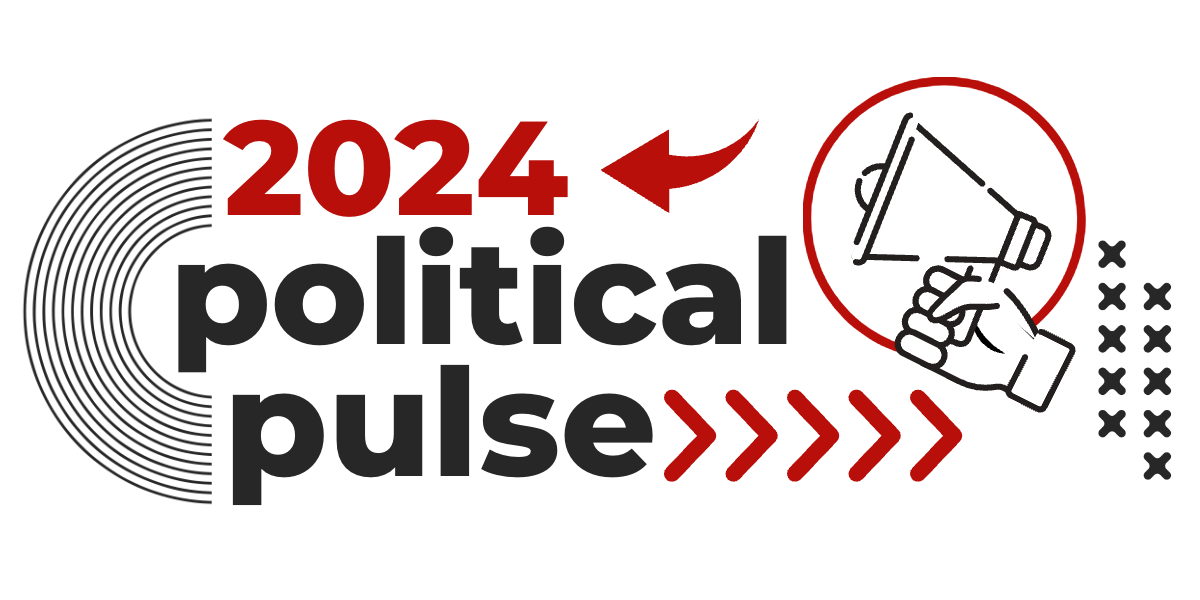DATA POINTS
- 1: The number of World Series the Texas Rangers have won
- 22%: The support Robert Kennedy has in a three-way poll including Biden and Trump
- 1967: The year Arizona opted out of Daylight Savings Time
- 2416: The passing yards secured by Miami Dolphins Quarterback Tua Tagovailoa so far this season
- $9.4 Million: The profit Starbucks made in the 4th quarter
- 328 Million: The amount Uber and Lyft agreed to pay for withholding money from drivers
 Is Trump’s Lead Too Much to Overcome?
Is Trump’s Lead Too Much to Overcome?
The newest sets of polls are in and former President Trump is dominating the primary outlook with 59.2% support from potential GOP voters. Since there are only 73 days until primary season begins, all candidates are in high pursuit to catch up to former President Trump’s polling numbers. It’s a big challenge for fellow Republican candidates to close the gap.
Despite President Biden only receiving a 39% approval rating, he maintains the closest shot at defeating Trump. According to the Emerson College poll and CNBC’s All-America Economic Survey, former President Trump leads against President Biden in a hypothetical rematch between the two candidates. The margins are slim, however, as Trump theoretically beats out Biden by anywhere between two and four points according to the polls.
Results show that Trump is taking the lead due to his growing support from 18- to 29-year-olds and 30- to 39-year-olds. It’s too early to tell if these will translate into real voters, though, as the 18-29 group is the most undecided demographic with 12% saying they do not know which of the two they would support in a rubber match.
The Rise of Home School
The COVID-19 pandemic had a lasting impact on education, but not only for the reasons you may think. Since the 2017-2018 academic school year, home schooling increased by 51%, far outpacing a 7% increase in private school enrollment. Public school enrollment is down 4%.
Why are more parents choosing to educate their kids at home? For some, the choice allows more time with family, nurturing values and teaching with a specific worldview. Others see it as a way to provide more customized learning through online platforms or individualized plans. Some may also consider alternative education as a way to shield kids from troubles like bullying or negative influences. Many parents stated concern with the intrusion of politics in the classroom and the ways sensitive cultural issues are handled.
But while some celebrate flexibility, others express concern over the lack of regulation and standardization. In most states, home-schooled kids are not required to submit reports of academic progress and do not take the same standardized tests as students in public school. Some also express concern that the lack of exposure to different perspectives may not best prepare students for college or the workplace.
The home schooling surge coincides with a heightened push for school choice. Some states, especially those led by conservative governors, have begun implementing private education school choice programs. Iowa Governor Kim Reynolds this year championed a new policy that provides over $7,000 per student in an education savings account to pay private school costs. Florida Governor Ron DeSantis also expanded the state’s educational voucher program in 2023.
Some note the diversification of education may come with a cost. With more families exiting the public system, those schools forego a portion of the dollars they receive for each student, which may impact some districts budgets relating to fixed costs.
Read More at The Washington Post
The Slow Downs of the Snow Towns

While the impacts are broad and far-reaching, ski towns will be hurt disproportionately as emissions continue to rise. These towns’ economies often revolve around snow sports, including the makers of recreational equipment and the business of snow removal contractors. With first frosts arriving later in the year, thaws becoming more prevalent during the winter, and declining snowfall, the industry may be in hot water. Even large companies including Toro, which sells personal snowblowers, are facing the heat.
But in a surprising turn of events, the warmer air may create more snow for the industry on some wintery days. Warmer air holds more vapor which creates more precipitation. So, when ski towns have warm winter days, they can expect a huge spike in snowfall as the cooler, higher-altitude air picks up the moisture. This trend, in addition to new technology to create manmade snow in higher temperatures, may serve to keep the snowsports industries alive and ski town economies on icy ground (where they like it best).
Read More at The Wall Street Journal
Problematic AI Alert: Racial Bias Edition

AI models developed in the U.S. have an inherent tendency toward a Western point-of-view, which can create troublesome results when generating images simulating international humans, architecture, lifestyles, and more. The problem oftentimes lies in the immense data set AI is trained on – billions of images with accompanying captions to explain what each image depicts. The captions are not usually drafted by humans; rather, by software that is notoriously unreliable.
The results produced by AI are oftentimes offensive. For example, 63% of food stamp recipients in the U.S. were white and only 27% were Black, but AI habitually generates dark-skinned people when prompted for a photo of a person receiving social services. However, when asked prompted for a productive person, the program almost exclusively generates middle-aged white men in corporate offices.
Not everything you see on the internet is true. A higher level of criticism and discretion should be held when working with AI image generators.
Read More at The Washington Post
New Weight Loss Drug May Starve Old Markets

This week, Bloomberg reported that Krispy Kreme shares fell (they weren’t so hot and ready) after investors pondered the future of the donut industry following the surge in demand for appetite-reducing drugs.
And donuts may not be the only victim. In the coming years, analysts predict Ozempic will likely drive down sales of sugary and unhealthy foods while elevating the sales of fitness products. Due to the increase in popularity of weight loss drugs, experts predict that overall calorie consumption in the U.S. will drop by a total of 3% by 2030.
But before you trade your gym membership for a pill bottle, be warned that Ozempic is not a magic weight loss drug, and it comes with significant downsides. The pill won’t only decrease your waist size – it may also empty your wallet. The drug can cost up to $900 a month without insurance. Because it was developed specifically for people with Type 2 Diabetes, people who take it for off-label indications can experience side effects like pancreatitis or malnourishment. Perhaps more importantly, it can create a shortage of the drug for people with diabetes, the demographic for which the medication was created.
Raised Credit Rates Razing Consumer Checkbooks

There are few checks and balances to keep credit rates down. In fact, there’s no national limit on credit card interest rates, barring a few exceptions for federal credit unions and protections for active service members. States often implement their own set of rules, so banks will do their business in states like Utah, Delaware, and South Dakota, where permissive rules exist. While there is discussion about capping credit interest rates on Capitol Hill, it is unlikely that Congress will address the issue. In the meantime, be sure to pay attention to any fees or interest rate hikes as you go about your holiday shopping.
INTERNATIONAL SPOTLIGHT
One Flu Over the Penguin’s Nest
The bird flu has appeared in the Antarctic region for the first time, and researchers are searching for the cause and figuring out what to do next. The first bird in the area that tested positive for the bird flu, a Giant Petrel, was found showing signs of sickness and died shortly after. Within a matter of days, other birds – brown skuas – were showing similar symptoms. The suspicious illness alarmed researchers from the British Antarctic Survey, who tested the birds and discovered the flu.
The newfound illness has researchers scratching their heads. How did this happen? They hypothesize the first bird ate an infected fish, migrated to Antarctica, then quickly spread it to the others. This theory would demonstrate a bird’s ability to travel extreme lengths before showing signs of sickness.
Scientists are working quickly to identify the root of this problem and ideate solutions. The bird flu is known to spread rapidly and to many kinds of animals, which could wipe out numerous populations of birds and potentially spread to mammals. If this outbreak is not quickly contained, the bird flu could spread at dangerous rates.
See you next week!
Be sure to follow us on Facebook, Twitter, and LinkedIn for more news and industry updates. To receive a copy of The Weekender in your inbox, sign up here.




 Is Trump’s Lead Too Much to Overcome?
Is Trump’s Lead Too Much to Overcome?


